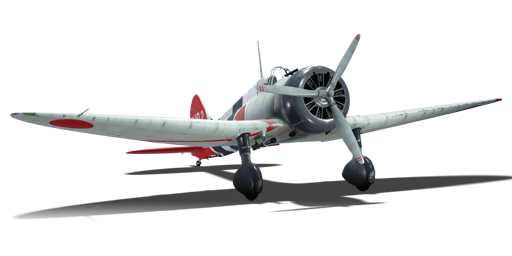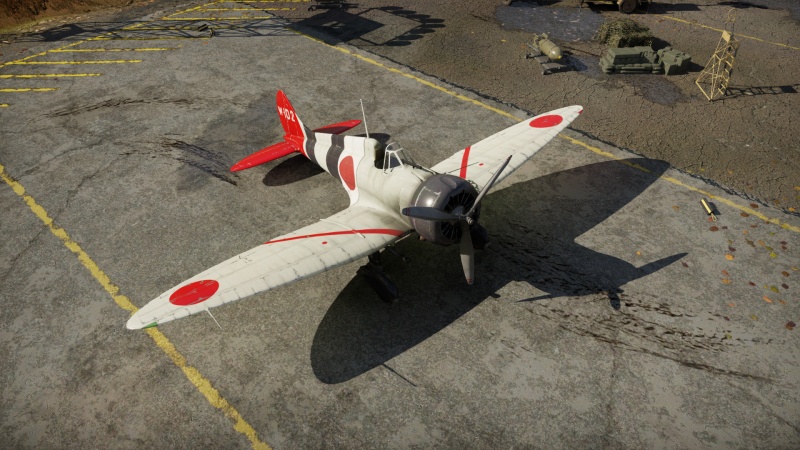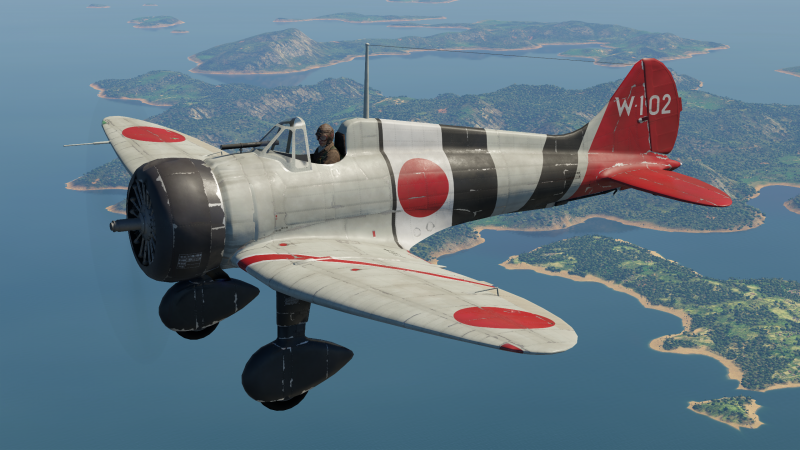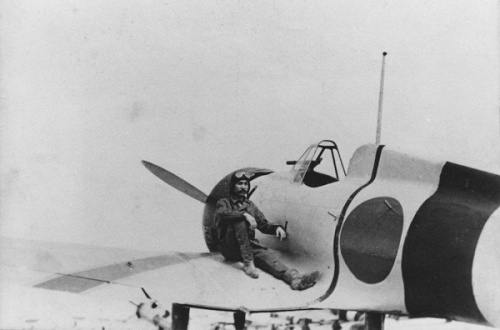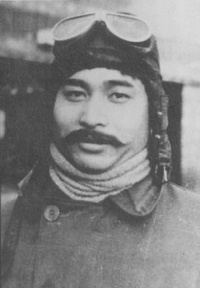Difference between revisions of "Hagiri's A5M4"
(→Description) |
m (→Armaments) |
||
| (5 intermediate revisions by 2 users not shown) | |||
| Line 11: | Line 11: | ||
== Description == | == Description == | ||
<!-- ''In the description, the first part should be about the history of and the creation and combat usage of the aircraft, as well as its key features. In the second part, tell the reader about the aircraft in the game. Insert a screenshot of the vehicle, so that if the novice player does not remember the vehicle by name, he will immediately understand what kind of vehicle the article is talking about.'' --> | <!-- ''In the description, the first part should be about the history of and the creation and combat usage of the aircraft, as well as its key features. In the second part, tell the reader about the aircraft in the game. Insert a screenshot of the vehicle, so that if the novice player does not remember the vehicle by name, he will immediately understand what kind of vehicle the article is talking about.'' --> | ||
| − | |||
| − | This [[A5M4]] (W-102) was piloted by the Japanese pilot Matsuo Hagiri during his time in the fighter squadron on the Sōryū aircraft carrier. He would become an ace during the Second Sino-Japanese War and in the Pacific theatre of World War II. His early successes came in the skies over China where he shot down 8 Chinese aircraft, with both his A5M4 (W-102) and an [[A6M]] which he was piloting as part of combat trials with other high-ranking Navy pilots. | + | This '''[[A5M4]] (W-102)''' was piloted by the Japanese pilot '''Matsuo Hagiri''' during his time in the fighter squadron on the Sōryū aircraft carrier. He would become an ace during the Second Sino-Japanese War and in the Pacific theatre of World War II. His early successes came in the skies over China where he shot down 8 Chinese aircraft, with both his A5M4 (W-102) and an [[A6M]] which he was piloting as part of combat trials with other high-ranking Navy pilots. |
| − | + | The '''{{Specs|name}}''' was introduced in [[Update 1.31]] and translates exactly over from reality, leading in monoplane manoeuvrability at the early ranks. It allows the pilot to evade and manoeuvre around their adversaries, as well as presenting a decent airframe that can take a beating from regular munitions. However, it lacks in damage output, being equipped with only two 7.7 mm machine guns. | |
== General info == | == General info == | ||
| Line 149: | Line 148: | ||
* 2 x 7.7 mm Type 89 machine guns, nose-mounted (500 rpg = 1,000 total) | * 2 x 7.7 mm Type 89 machine guns, nose-mounted (500 rpg = 1,000 total) | ||
| + | |||
| + | === Suspended armament === | ||
| + | {{Specs-Avia-Suspended}} | ||
| + | <!-- ''Describe the aircraft's suspended armament: additional cannons under the wings, bombs, rockets and torpedoes. This section is especially important for bombers and attackers. If there is no suspended weaponry remove this subsection.'' --> | ||
| + | {{main|Navy Type 97 Number 6 (60 kg)}} | ||
| + | |||
| + | The '''''{{PAGENAME}}''''' can be outfitted with the following ordnance: | ||
| + | |||
| + | * Without load | ||
| + | * 2 x 60 kg Navy Type 97 Number 6 bombs (120 kg total) | ||
== Usage in battles == | == Usage in battles == | ||
| Line 253: | Line 262: | ||
== See also == | == See also == | ||
| − | ''Links to the articles on the War Thunder Wiki that you think will be useful for the reader, for example:'' | + | <!-- ''Links to the articles on the War Thunder Wiki that you think will be useful for the reader, for example:'' |
* ''reference to the series of the aircraft;'' | * ''reference to the series of the aircraft;'' | ||
| − | * ''links to approximate analogues of other nations and research trees.'' | + | * ''links to approximate analogues of other nations and research trees.'' --> |
| + | |||
| + | ;Related development | ||
| + | * [[A5M4]] | ||
| + | |||
| + | ;Aircraft of comparable role, configuration and era | ||
| + | * [[Ki-27 otsu]] | ||
| + | * [[F2A (Family)]] | ||
| + | * [[P-26 (Family)]] | ||
| + | * [[G.50 (Family)]] | ||
| + | * [[I-16 (Family)]] | ||
== External links == | == External links == | ||
Latest revision as of 09:05, 16 December 2023
| This page is about the premium Japanese fighter Hagiri's A5M4. For the regular version, see A5M4. |
Contents
Description
This A5M4 (W-102) was piloted by the Japanese pilot Matsuo Hagiri during his time in the fighter squadron on the Sōryū aircraft carrier. He would become an ace during the Second Sino-Japanese War and in the Pacific theatre of World War II. His early successes came in the skies over China where he shot down 8 Chinese aircraft, with both his A5M4 (W-102) and an A6M which he was piloting as part of combat trials with other high-ranking Navy pilots.
The Hagiri's A5M4 was introduced in Update 1.31 and translates exactly over from reality, leading in monoplane manoeuvrability at the early ranks. It allows the pilot to evade and manoeuvre around their adversaries, as well as presenting a decent airframe that can take a beating from regular munitions. However, it lacks in damage output, being equipped with only two 7.7 mm machine guns.
General info
Flight performance
| Characteristics | Max Speed (km/h at 2,900 m) |
Max altitude (metres) |
Turn time (seconds) |
Rate of climb (metres/second) |
Take-off run (metres) | |||
|---|---|---|---|---|---|---|---|---|
| AB | RB | AB | RB | AB | RB | |||
| Stock | 431 | 421 | 9800 | 12.5 | 13.4 | 10.0 | 10.0 | 325 |
| Upgraded | 464 | 447 | 12.1 | 12.3 | 16.7 | 12.8 | ||
Details
| Features | ||||
|---|---|---|---|---|
| Combat flaps | Take-off flaps | Landing flaps | Air brakes | Arrestor gear |
| ✓ | ✓ | ✓ | X | ✓ |
| Limits | ||||||
|---|---|---|---|---|---|---|
| Wings (km/h) | Gear (km/h) | Flaps (km/h) | Max Static G | |||
| Combat | Take-off | Landing | + | - | ||
| 558 | 558 | 398 | 369 | 220 | ~12 | ~4 |
| Optimal velocities (km/h) | |||
|---|---|---|---|
| Ailerons | Rudder | Elevators | Radiator |
| < 280 | < 320 | < 360 | > 324 |
Engine performance
| Engine | |||||
|---|---|---|---|---|---|
| Engine Name | Number present | ||||
| Nakajima Kotobuki 41 9-cylinder | 1 | ||||
| Engine characteristics | |||||
| Weight (each) | Type | Cooling | |||
| 350 kg | Radial | Air | |||
| Engine power (Stock) | |||||
| Mode | Max | Take-off | |||
| Arcade | 557 hp | 656 hp | |||
| Realistic/Simulator | 551 hp | 650 hp | |||
| Engine power (Upgraded) | |||||
| Mode | Max | Take-off | |||
| Arcade | 700 hp | 799 hp | |||
| Realistic/Simulator | 619 hp | 718 hp | |||
| WEP Duration | |||
|---|---|---|---|
| Arcade | Realistic/Simulator | ||
| 25 seconds | Infinite | ||
Survivability and armour
- No armour
- Non-self-sealing fuel tanks (2 in each wing)
- Oil cooling systems located in prone position (in each inner top part of the wing)
- Open cockpit
Modifications and economy
Armaments
Offensive armament
Hagiri's A5M4 is armed with:
- 2 x 7.7 mm Type 89 machine guns, nose-mounted (500 rpg = 1,000 total)
Suspended armament
The Hagiri's A5M4 can be outfitted with the following ordnance:
- Without load
- 2 x 60 kg Navy Type 97 Number 6 bombs (120 kg total)
Usage in battles
The Hagiri's A5M4 is to be used in a fighter role, staying low and using the extremely quick turn times to get on the tail on the enemy is essential. Keep an eye on ammo levels and well as your surroundings, this is an extremely weak aircraft in terms of armour. It is relatively fast in a straight line, but not as quick as much of the opposition it will be facing in the game. It is recommended to use speed against biplanes as their turn times are nearly matched if not better than this monoplane.
Realistic battles
The A5M4 can accelerate to 350 km/h in just less than a minutes time from takeoff. Will climb up to 2,500 m in around one minute and fifty seconds time when climbing in a 20-degree angle. Dive speeds are decent as the A5M4 will exceed 550 km/h in an 80-degree angle from just 2,500 m height. Be careful though, once the A5M4 reaches 560 km/h, the plane will violently shake about and if the throttle isn't cut, the plane wings may rip off. Though speed can be gained in the dive, energy is not easily retained, taking only a minute or so to fall to back to the maximum speed of 380 km/h with WEP or 360 km/h without.
Decent horsepower with the typical Japanese light aircraft would give the idea that the plane would be great in the vertical axis dog fighting. With a problem with keeping constant fuel flow as the plane changes the angle on its vertical axis means it is better to stick with horizontal dog fighting which isn't a bad thing as it will outturn most all contemporary aircraft.
Simulator mode procedures
Hands-off carrier take-off (Auto engine control): Ignite engine, flaps: raised, elevator trim: 6% up, aileron trim: 0%, rudder trim: 21% right, WEP throttle, hands off controls until the plane lifts off the carrier.
Manual Engine Control
| MEC elements | ||||||
|---|---|---|---|---|---|---|
| Mixer | Pitch | Radiator | Supercharger | Turbocharger | ||
| Oil | Water | Type | ||||
| Controllable | Controllable Not auto controlled |
Controllable Auto control available |
Controllable Auto control available |
Separate | Not controllable 1 gear |
Not controllable |
Pros and cons
Pros:
- A5M for Carrier-based fighter:
- Arrestor hook
- Strictly air-to-air role
- Extremely manoeuvrable
- Excellent turn rate
- Very short takeoff distance
- Common Navy plane construction:
- Excellent manoeuvrability
- Nose mounted armament
- A5M specific:
- Good visibility (In cockpit view)
- Low stall speed
- Fixed landing gear makes landings easier
Cons:
- A5M for Carrier-based fighter:
- Slow
- Low dive speed, and easily compressed in a dive
- Common Navy plane construction:
- Poor offensive armament: 7.7 mm Type 89 MG
- Fragile, little armour, and no self-sealing fuel tanks
- A5M specific:
- Exposed pilot
- Fixed landing gear creates more drag
- Suffers from fuel starvation problems (RB/SB)
History
Matsuo Hagiri
From War Thunder News:
Matsuo Hagiri was born in Shizuoka Prefecture on the southern coast of the Japanese island of Honshu in November 1913. After finishing school he worked briefly as a fireman before joining the Enlisted ranks of the Imperial Japanese Navy. A gifted aviator, Hagiri was streamed onto single seat fighters after the excelling during the notoriously harsh and competitive training regime of Japanese naval aviators. He graduated from flying training in 1935; by 1939 he had risen through the ranks to become a Petty Officer – 1st Class and flew the Mitsubishi A5M4 fighter as part of the carrier Soryu's embarked fighter squadron. Soryu was stationed in home waters for training after a busy period of operations during the Second Sino-Japanese War. In August 1940 Hagiri joined the 12th Ku - his unit were shortly to equip with the new Mitsubishi A6M "Zero" – a move which was met with some resentment at first by some pilots as the older A5M4 was able to outmanoeuvre the newer fighter in a variety of scenarios during mock dog fights. Hagiri was one of the pilots selected to transport the first batch of new Zero fighters across to Hankow, China for operational use.However, Hagiri persevered and on August 19th 1940 was one of the pilots who flew with the 12th Air Group in the historic combat debut of the legendary fighter. The mission, led by Lieutenant Tomotsu Yokoyama, involved twelve A6M fighters escorting a bomber force to Chunking. Whilst the Japanese aircraft were not engaged in air-to-air combat the Zero did stun the world by establishing a new record for the longest distance escort mission flown by a single engine fighter at over 1000 nautical miles. However, when the Zero saw its combat debut the next month with Japanese naval pilots claiming 27 Chinese I-15s and I-16s shot down without loss in a single engagement, Hagiri – like his peers – found a new found confidence and respect in his aircraft.
By now a confident and flamboyant character (he grew a long, waxed moustache giving rise to his nickname 'Mustachio') Hagiri joined three other pilots from his unit in a dangerous prank on October 4th, 1940. The four Zero pilots flew to the Chinese airbase at Taipingsze, Chengtu where the four Japanese pilots landed, jumped out of their aircraft and attempted to vandalize a row of parked Chinese aircraft and set fire to the base command post. The alarm was swiftly raised and the four Japanese pilots were forced to sprint for their Zeros, bullets whistling past them as they fled. However, Hagiri still managed to find an opportunity to break away from his comrades and engage three Chinese fighters alone, shooting down two of them before heading for home. By the time Hagiri was rotated out of combat and returned to Japan he had shot down seven Chinese aircraft. With the outbreak of hostilities against the British Commonwealth and the United States, Hagiri was employed in Japan as an instructor.
The next busy period of operations for Hagiri came in July 1943 when, now promoted to Warrant Officer, he flew as part of the 204th Air Group in the Solomon Islands. On September 23rd Hagiri flew as part of a twenty seven aircraft Wing to intercept a combined American/Australian bombing raid against Kahili Airfield in Papua New Guinea and its surrounding anti-aircraft defences. Hagiri shot down two F4U Corsairs of the US Marine Corps (possibly three, according to some sources), but was so severely injured that his treatment required him to return to Japan. After recovering, Hagiri remained in Japan as a test pilot. However, he did see combat again when, along with several other test pilots, he was involved in defensive operations against American bombing raids on the mainland, during which he claimed two B-29 Superfortresses destroyed. In April 1945, he was wounded again by defensive fire from a B-29; this would be Hagiri's last flight.
Matsuo Hagiri is credited with between thirteen and fifteen victories; he passed away on January 15th 1997.
| Archive of the in-game description | |
|---|---|
|
An all-metal single-seat fighter with an open cockpit and unretractable landing gear, it was the first carrier-based monoplane fighter in the world. Its prototype got off the ground for the first time on February 4, 1935. This aircraft, with the tail number W-102, was part of the fighter squadron based on the aircraft carrier Souryu, of the Imperial Japanese Navy. It was piloted by Matsuo Hagiri, a Japanese ace and test pilot who shot down 13 enemy planes. Hagiri was among the first sortie of Zeroes that accompanied the bombers during the Chongqing air raid. | |
Media
- Skins
- Images
- Videos
See also
- Related development
- Aircraft of comparable role, configuration and era
External links
| Mitsubishi Company (三菱商会) | |
|---|---|
| Fighters | A5M4 · Hagiri's A5M4 |
| A6M2 mod. 11 · A6M2 · A6M3 · A6M3 mod. 22 · A6M3 mod. 22Ko · A6M5 · A6M5 Ko · A6M5 otsu · A6M5 Hei · A6M6c | |
| A7M1 (NK9H) · A7M2 | |
| J2M2 · J2M3 · J2M4 Kai · J2M5 · J2M5 (30 mm) | |
| Hydroplanes | F1M2 |
| Interceptors | Ki-83 · Ki-109 |
| Bombers | G4M1 |
| Ki-21-Ia · Ki-21-I hei · Ki-67-I Ko · Ki-67-I otsu | |
| Jet Fighters | Ki-200 |
| Captured | ▃A6M2 · ␗A6M2 |
| See also | Mitsubishi Heavy Industries, Ltd. (Post-War) |
| Japan fighters | |
|---|---|
| Navy | |
| Carrier-based fighter | |
| A5M | A5M4 · Hagiri's A5M4 |
| A6M | A6M2 mod. 11 · A6M2 · A6M3 · A6M3 mod. 22 · A6M3 mod. 22Ko · A6M5 · A6M5 Ko · A6M5 otsu · A6M5 Hei · A6M6c |
| A7He | A7He1* |
| A7M | A7M1 (NK9H) · A7M2 |
| Land-based Fighter | |
| J2M | J2M2 · J2M3 · J2M4 Kai · J2M5 · J2M5 (30 mm) |
| J6K | J6K1 |
| J7W | J7W1 |
| N1K-J | N1K1-Ja · N1K2-J · N1K2-Ja |
| Fighter seaplane | |
| N1K | N1K1 |
| A6M-N | A6M2-N |
| Army | |
| Ki-10 | Ki-10-I · Ki-10-I C · Ki-10-II · Ki-10-II C |
| Ki-27 | Ki-27 otsu · Ki-27 otsu Tachiarai |
| Ki-43 | Ki-43-I · Ki-43-II · Ki-43-III otsu |
| Ki-44 | Ki-44-I · Ki-44-I 34 · Ki-44-II otsu · Ki-44-II hei |
| Ki-61 | Ki-61-I ko · Ki-61-I otsu · Ki-61-I hei · Tada's Ki-61-I hei · Ki-61-I tei · Ki-61-II Otsu Kai |
| Ki-84 | Ki-84 ko · Ki-84 otsu · Ki-84 hei |
| Ki-87 | Ki-87 |
| Ki-94 | Ki-94-II |
| Ki-100 | Ki-100 · Ki-100-II |
| Other countries | ▅F4U-1A · ▅P-51C-11-NT · ▅Bf 109 E-7 · ▅Fw 190 A-5 |
| *Imported designation of the He 112 (A6M was in development - A7M would take A7 designation after the cancelation of the A7He) | |
| Japan premium aircraft | |
|---|---|
| Fighters | Hagiri's A5M4 · A7He1 · Ki-27 otsu Tachiarai |
| Ki-44-II otsu · ▅Bf 109 E-7 · ▅F4U-1A · Ki-100-II · Ki-44-I 34 | |
| ▅Fw 190 A-5 · A7M1 (NK9H) · Tada's Ki-61-I hei · ▅P-51C-11-NT | |
| J2M4 Kai · A6M5 Ko · A6M6c · J2M5 · Ki-87 · J6K1 | |
| Twin-engine fighters | Ki-96 |
| Jet fighters | F-86F-40 JASDF▅ · T-2 Early · F-4EJ ADTW |
| Strike aircraft | ▄AV-8S |
| Bombers | Ki-21-I hei · Ki-48-II otsu · H8K3 · B7A2 (Homare 23) · ▅B-17E |


